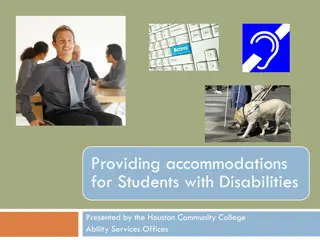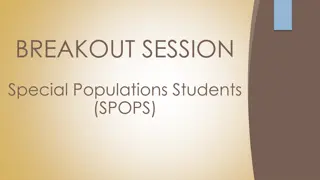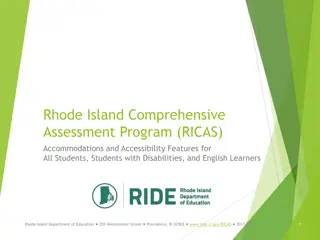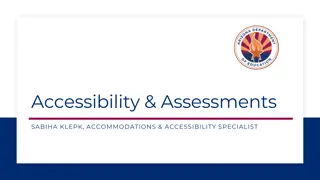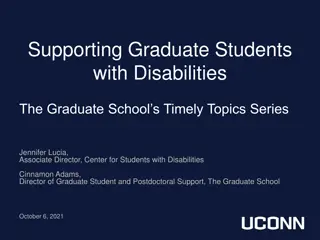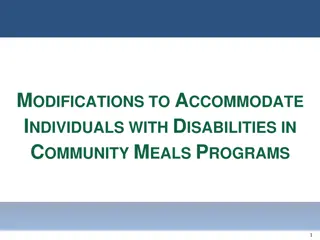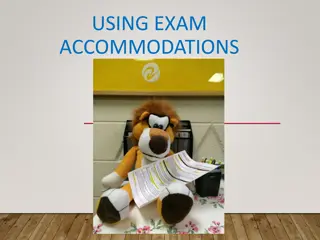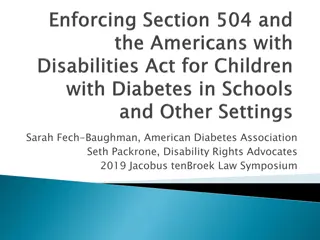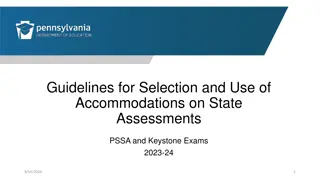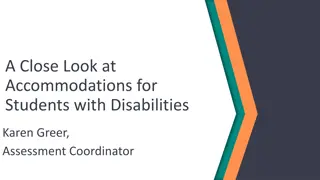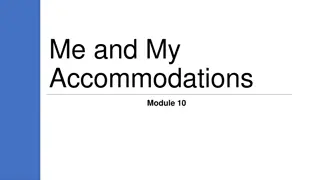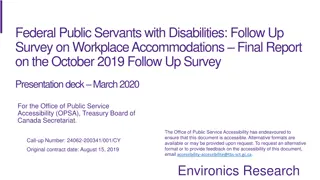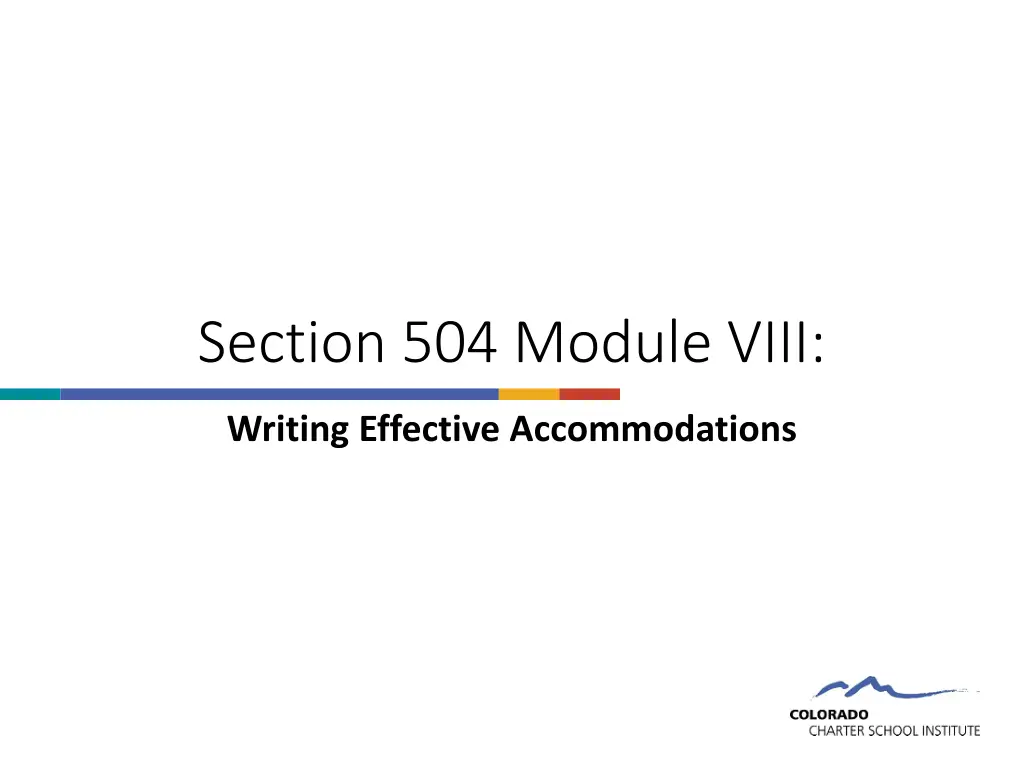
Writing Effective Accommodations in Education
Understand the principles, types, and foundations of accommodations in Section 504 plans. Learn how accommodations differ from modifications and discover key strategies for creating effective accommodations tailored to individual student needs.
Download Presentation

Please find below an Image/Link to download the presentation.
The content on the website is provided AS IS for your information and personal use only. It may not be sold, licensed, or shared on other websites without obtaining consent from the author. If you encounter any issues during the download, it is possible that the publisher has removed the file from their server.
You are allowed to download the files provided on this website for personal or commercial use, subject to the condition that they are used lawfully. All files are the property of their respective owners.
The content on the website is provided AS IS for your information and personal use only. It may not be sold, licensed, or shared on other websites without obtaining consent from the author.
E N D
Presentation Transcript
Section 504 Module VIII: Writing Effective Accommodations
Foundation: Understanding Accommodations Foundation: Understanding Accommodations What are Accommodations? Changes, adaptations, work-arounds for the disability that do not change learning expectations. Allow the student to have access despite a disabling condition. Still expected to know the same material and demonstrate the same level of competence in the content/skill. Alterations made to allow an individual with a disability the ability to access information or complete a task.
Foundation: Understanding Types of Accommodations Foundation: Understanding Types of Accommodations Presentation: How the information is provided to the student- auditory, verbally, tactile, visual Response: How the student completes assignments/tests, provides responses in class, etc. (use of AT device, orally, in written form) Setting/Environmental: Location of the assignment completion/test, environmental conditions (e.g., seating arrangements, movement in classroom, breaks) Timing/Scheduling: Change the timing of how the assignment/test is completed (more time, different time, more sessions)
Foundation: Understanding Modifications What are Modifications? Examples: Use of Alternative Texts, Reading passages Modifications change what the student is taught or expected to learn, changes in the curriculum Modified Grading Students that require changes in the content of the curriculum often have difficulty with comprehending the content Modified Standards Learning different material Typically, Section 504 plans are composed of accommodations rather than accommodations.
Principles of Effective Accommodations Principles of Effective Accommodations Individualized Tailored to the specific needs of the student Accommodations should be practical and not place an undue burden (hardship) on the school Reasonable Ensure that the student can participate in the learning environment equally If a service is provided, the purpose is to enable the student to access their education Focused on Access from assessment to condition, areas of impact and accommodations Limit accommodations to areas specific to the condition Maintain the Thread
Common Pitfalls in Writing Accommodations Common Pitfalls in Writing Accommodations Example: Provide help as needed lacks clarity on what type of help and when Too Vague Example: Preferential seating needs specification on where the student should sit and why Too General Example: Example: Allow extra time to complete assignments and tests needs specification on when and how much time Unrelated to the Disability Ensure accommodations directly address the student s impairment
Writing Clear and Actionable Accommodations Writing Clear and Actionable Accommodations Key Points: Use clear, specific language. Avoid vague terms like as needed or when necessary. Include concrete strategies (e.g., allow up to 50% extra time on all tests ). Make accommodations measurable and observable.
For a Student with Dyslexia Student needs additional processing time to read questions and produce written responses Specific and Specific and Measurable Measurable Accommodations Accommodations When reading passages and directions, or being required to produce written responses allow student time and a half extra to complete assignments Allow student extra time to complete quizzes, tests and in-class assignments
Specific and Specific and Measurable Measurable Accommodations Accommodations- - Examples Examples Repeat oral directions and check for understanding (e.g., have the student repeat the directions in own words) for all assignments, tests, and quizzes.
Specific and Specific and Measurable Measurable Accommodation Accommodation- - Anxiety Anxiety
Specific and Specific and Measurable Measurable Accommodations Accommodations- - ADHD ADHD
Specific and Specific and Measurable Measurable Accommodations Accommodations- - ADHD Examples ADHD Examples Utilize a self-charting system for completion of tasks, combined with reinforcement, to increase student ownership for managing completion of tasks
Accommodation Plan Example with Multiple Related Accommodations: ADHD/Concentration/Focus ADHD/Concentration/Focus A. Allow movement breaks (e.g., standing, stretching, breathing exercises for 5-10 minutes in the back of the room) every 30 minutes during class, while ensuring that the breaks do not disrupt other students. Provide student with a timer with suggested times to help student stay on-task when working on in-class assignments. Utilize a self-charting system, combined with reinforcement, to increase student s self-management skills and ownership for completion of tasks B. C.
Tip: Use Lists of Accommodations by Areas of Concern Dozens of excellent lists of accommodations broken down by areas of concern are free on the internet: Examples: Pennsylvania State Education Association Accommodations Guidebook Lisa Lightner's list from 'A Day in Our Shoes PACER parent Center List Caution: Need to edit accommodations and make them more specific/individualized Need to keep in mind allowable CDE assessment accommodations
Important Considerations Related to 504 Accommodations Implementation of Plan Common Issue: A common problem identified by the OCR is schools failing to properly implement accommodations listed in a student s 504 plan. Training General Education Staff Common Issue: Many Section 504 violations occur due to staff not being adequately trained on what accommodations are required or how to implement them.
Common Legal Considerations Related to Implementation of Accommodations Discrimination or Exclusion Based on Disability: Common Issue: Students with disabilities were disproportionately subjected to suspensions, denied participation in extracurricular activities, or placed in segregated settings. Documentation: Use of Accommodations and Log Services 504 Training for staff
Common Legal Considerations. Individualization Common Issue: Some schools apply a one-size-fits-all approach to accommodations, which results in inadequate support for students whose disabilities require more specific modifications. Access to Assistive Technology Common Issue: Schools may fail to provide necessary assistive technology that is critical for students with disabilities to access the curriculum.
Common Legal Considerations Thread between Assessment, Condition, and Accommodations: Common Issues: Accommodations not directly related to findings in assessment too broad, need for accommodation not linked to condition. Example: Student identified with Dyslexia only but receives accommodations for breaks outside the classroom Too Many/Redundant Accommodations: Common Issue: too many accommodations to implement with fidelity, confusing and often redundant/overapping accommodations Accessibility for Extra-Curricular and After-School Programs Common Issue: Cases have shown that some schools fail to provide physical accessibility in classrooms, transportation, or extracurricular activities for students with mobility impairments.


